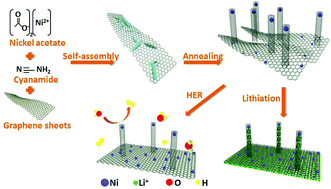MOF-derived uniform Ni nanoparticles encapsulated in carbon nanotubes grafted on rGO nanosheets as bifunctional materials for lithium-ion batteries and hydrogen evolution reaction†
Abstract
The rational-design and synthesis of transition-metal compounds with outstanding electrochemical activity and durability for renewable energy systems have attracted tremendous research interest in recent years. Herein, we report a facile and unique strategy to synthesize N-doped carbon nanotube-encapsulated Ni nanoparticles on reduced graphene oxide (Ni@NC-rGO). The optimized nanostructure determines the synergetic effects among the Ni nanoparticles, N-doped CNTs and graphene nanosheets, thus resulting in extraordinary electrochemical performances. When applied as an anode for lithium-ion batteries (LIBs), the Ni@NC-rGO electrode displayed high reversible capacity, stable cycling performance and superior rate capability. Moreover, the resulting Ni@NC-rGO nanocomposites exhibited low overpotential and considerable durability for the hydrogen evolution reaction (HER). Our study may provide a feasible methodology for the preparation of high-performance nanostructured materials for practical energy storage and conversion applications.



 Please wait while we load your content...
Please wait while we load your content...